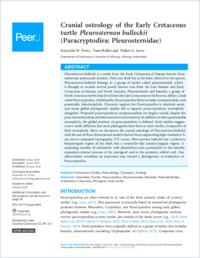Cranial osteology of the early cretaceous turtle Pleurosternon bullockii (paracryptodira: pleurosternidae)
- Evers, Serjoscha W. Department of Geosciences, University of Fribourg, Fribourg, Switzerland
- Rollot, Yann Department of Geosciences, University of Fribourg, Fribourg, Switzerland
- Joyce, Walter G. Department of Geosciences, University of Fribourg, Fribourg, Switzerland
-
30.06.2020
Published in:
- PeerJ. - 2020, vol. 8, p. e9454
English
Pleurosternon bullockii is a turtle from the Early Cretaceous of Europe known from numerous postcranial remains. Only one skull has so far been referred to the species. Pleurosternon bullockii belongs to a group of turtles called pleurosternids, which is thought to include several poorly known taxa from the Late Jurassic and Early Cretaceous of Europe and North America. Pleurosternids and baenids, a group of North American turtles that lived from the Late Cretaceous to the Eocene, define a clade called Paracryptodira. Additionally, Paracryptodira likely includes compsemydids, and, potentially, helochelydrids. Character support for Paracryptodira is relatively weak, and many global phylogenetic studies fail to support paracryptodiran monophyly altogether. Proposed paracryptodiran synapomorphies are largely cranial, despite the poor characterization of pleurosternid cranial material. In addition to their questionable monophyly, the global position of paracryptodires is debated. Early studies suggest crown-turtle affinities, but most phylogenies find them as stem-turtles, irrespective of their monophyly. Here, we document the cranial osteology of Pleurosternon bullockii with the use of three-dimensional models derived from segmenting high-resolution X-ray micro-computed tomography (CT) scans. Pleurosternon bullockii has a primitive basipterygoid region of the skull, but a cryptodire-like acustico-jugular region. A surprising number of similarities with pleurodires exist, particularly in the laterally expanded external process of the pterygoid and in the posterior orbital wall. Our observations constitute an important step toward a phylogenetic re-evaluation of Paracryptodira.
- Faculty
- Faculté des sciences et de médecine
- Department
- Département de Géosciences
- Language
-
- English
- Classification
- Palaeontology
- License
- License undefined
- Identifiers
-
- RERO DOC 328835
- DOI 10.7717/peerj.9454
- Persistent URL
- https://folia.unifr.ch/unifr/documents/308709
Statistics
Document views: 99
File downloads:
- joy_coe.pdf: 95
